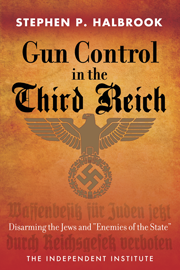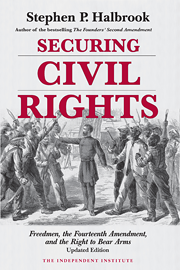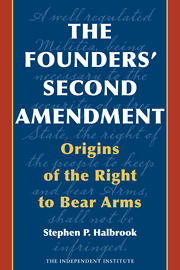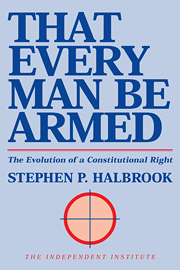The Constitution protects each American’s right to own a firearm. Pending before the U.S. Supreme Court is United States vs. Emerson, a case which involves the right to keep and bear arms guaranteed by the Second Amendment to the Constitution. Attorney General John Ashcroft believes that this is a fundamental right of law-abiding citizens, but argues that the federal law at issue in the case is valid. The law prohibits firearm possession by a person against whom an order has been entered restraining the person from domestic violence. Ashcroft’s pro-Second Amendment views have provoked a firestorm among gun prohibitionists.
When she was attorney general, Janet Reno never said anything good about that part of the Bill of Rights known as the Second Amendment. She was the chief prosecutor for Clinton’s gun control measures, and the only arms bearing she took “full responsibility for” was by submachine-gun toting federal agents at Waco and in Miami’s Little Havana.
When Dr. Timothy Emerson argued that the federal ban on possession of a firearm by the subject of a domestic restraining order violated the Second Amendment, the prosecuting U.S. attorney in Lubbock, Texas, echoed Reno’s line that the people have no right to keep and bear arms.
But U.S. District Judge Sam Cummings had read up on his constitutional history, and threw out the prosecution. His 1999 decision, considered by some the most thoroughly researched judicial opinion ever published on the Second Amendment, held that the gun ban was an infringement on the right to keep arms, and that the restraining order in that case was just a boilerplate form issued in every Texas divorce case. He quoted the Founding Fathers and the latest scholarship to show that the Second Amendment protects an individual’s right to have a firearm.
The Second Amendment states: “A well regulated militia, being necessary to the security of a free state, the right of the people to keep and bear arms, shall not be infringed.” To the framers, it was simple enough: Recognition of the right of all law-abiding persons to have firearms would promote a militia, which is superior to a standing army for protection of liberty. Promotion of the militia was a serious federal purpose, but the right was not limited to militia use.
By the 1960s, the Second Amendment had become politically incorrect, and some judges and prosecutors concocted the theory that “the right of the people” to have arms really means “the power of the state” to have a militia. If the amendment protects only the collective and gun owners have no rights, then all gun control laws are constitutional.
But that mentality is hardly universal. In September 1998, then-Sen. John Ashcroft, chairman of the subcommittee on the constitution, held hearings on the Second Amendment. He quoted James Madison as praising “the advantage of being armed, which the Americans possess over the people of almost every other nation.” Democrat Russ Feingold declared, “I agree with every single word Sen. Ashcroft said about the amendment.” That view would be buttressed the following year with the decision by Judge Cummings.
The appeal of that decision was heard at the U.S. Court of Appeals for the Fifth Circuit in New Orleans. A Justice Department lawyer told the three-judge panel that a government ban on all civilian gun possession would not violate the Second Amendment. That comment was widely published, prompting an uproar in the gun-owning community.
When one citizen asked whether they really meant it, then-Solicitor General Seth Waxman wrote a detailed letter explaining that, yes, there is no Santa Claus, and the Second Amendment is kaput. The letter was dated August 2000, when the Gore-Bush race was in full swing. The National Rifle Association posted blowups of the letter on billboards, and it is now history how key hunting states swung the election for Bush.
Sticking to his guns
Ashcroft survived the bashing at his conformation hearing and became attorney general despite the fears of many that he would be a staunch defender of the Second Amendment. Their nightmare came true in May 2001 when Jim Baker, political chief of the National Rifle Association (NRA), read a letter from Ashcroft to the group’s annual convention. It pledged: “Let me state unequivocally my view that the text and the original intent of the Second Amendment clearly protects the right of individuals to keep and bear firearms.”
Ashcroft quoted Jefferson’s proposal for Virginia that “no free man shall ever be debarred the use of arms,” and George Mason’s protest of a Constitution with no bill of rights, including his remark that “to disarm the people is the best and most effectual way to enslave them.”
But Congress could restrict firearms “for compelling state interests,” such as disarming felons. Ashcroft recalled Samuel Adams’ admonition in 1788 that the Constitution should “never (be) construed to prevent the people of the United States who are peaceable citizens from keeping their own arms.”
The gun prohibitionist lobby went ballistic. The Violence Policy Center ignored the above words and charged that, under Ashcroft’s views, violent felons would assert their Second Amendment rights. Actually, the Violence Policy Center couldn’t care less what felons assert—it found intolerable the concession that peaceable citizens could keep their own arms. VPC litigation director Mathew Nosanchuk, Reno’s former top firearms counsel, wrote a blistering attack unmasking Ashcroft’s heresy.
9/11 changed things
Then came Sept. 11. The heroic resistance of the passengers on United Airlines Flight 93 against the hijackers seemed to consign the doctrine of nonresistance (typical of anti-gun pacifists) to the dustbin of history.
The U.S. Court of Appeals in the Emerson case was not cowed. Its opinion, issued in October, held: “The Second Amendment protects the right of individuals to privately keep and bear their own firearms that are suitable as individual, personal weapons regardless of whether the particular individual is then actually a member of a militia.”
Published as U.S. vs. Emerson, the 70-page opinion leaves other appellate court decisions in the dust. Filled with a sophisticated textual analysis and extensive quotes from the Founding Fathers, the opinion demolishes the “collective rights” decisions of several other courts, which typically rely on a paragraph or two of assertion. The court held that the law at issue barely passed muster under the Second Amendment, in that domestic restraining orders in Texas are required to be backed by judicial fact-finding.
Emerson’s attorneys filed a petition for review in the Supreme Court. Would the Ashcroft Justice Department respond with the typical Clinton-era refrain, or would it honestly concede that “the right of the people” is for real? A bitter internal fight broke out in the Justice Department between Ashcroft loyalists and career bureaucrats.
The contents of briefs for the United States in the drafting stage are not normally available for eavesdropping by interest groups. However, a draft of the U.S. brief in the Emerson case may have been leaked to the Violence Policy Center. Forewarned that the brief would endorse Emerson’s individual rights-interpretation of the Second Amendment, VPC sent a missive signed by Andrew Frey, ex-deputy solicitor general, to Solicitor General Ted Olson, lecturing Olson on why the brief must not commit this “politically motivated” apostasy.
The department, Frey insisted, must never relax its iron denial of any Second Amendment right. It had argued in a 1939 brief that the amendment’s right extended only to “the people collectively” as a militia. However, the Supreme Court’s decision, United States vs. Miller (1939), was silent on that argument, holding instead that the Second Amendment protects a firearm if it “is any part of the ordinary military equipment, or that its use could contribute to the common defense.” The court never suggested that the possessor had to be in the militia. Miller has been widely mis-cited as supportive of the collective rights theory, but it contains no such language.
Legislative justification
Frey argued that the Justice Department’s briefs represent “the position of the United States,” but a more reliable statement of that position has been expressed in acts of Congress. Just two years after the brief in Miller was filed, the Property Requisition Act of 1941 prohibited any construction of the law that would “impair or infringe in any manner the right of any individual to keep and bear arms.” Congress passed that law and President Franklin D. Roosevelt signed it.
Similarly, in the Firearms Owners’ Protection Act of 1986, Congress recognized “the rights of citizens to keep and bear arms under the Second Amendment to the United States Constitution.”
As the coup de grace, Frey appealed to the Machiavellian impulse: The Second Amendment’s validity must not be admitted because it would make it harder to win cases. The same could be said about any constitutional right.
On May 6, the VPC’s “Nightmare on Elm Street” came true with the filing of the U.S. brief in Emerson. It states that the Second Amendment “broadly protects the rights of individuals, including persons who are not members of any militia to possess and bear their own firearms,” excluding “possession by unfit persons” and firearm types “particularly suited to criminal misuse.” Although the latter is fuzzy, the brief makes clear that handguns, rifles and shotguns are protected.
Attached to the brief was a November 2001 memo from Ashcroft to all U.S. attorneys with the words: “The department has a solemn obligation both to enforce federal law and to respect the constitutional rights guaranteed to Americans.”
It’s his respect for the Constitution that drives Ashcroft’s critics bananas, and it’s that same respect that gives assurance that the office of attorney general is held by a man of integrity.















